Image: Bands of the Indian military sound the retreat during the Beating the Retreat ceremony in New Delhi
Photographs: B Mathur/Reuters
Photographs: B Mathur/Reuters
Soul-stirring martial tunes and solemn drumbeats reverberated in the air while the majestic Raisina Hills was lit up coinciding with the sunset as part of the Beating the Retreat ceremony in New Delhi on Saturday.
The ceremony, which marks the conclusion of Republic Day celebrations, saw bands from three armed services in their colourful ensembles playing tunes like 'Indian Star', 'March of the Mariners', 'Amar Senani', 'Sare Jahan Se Achcha' and two new compositions -- 'Gaj Raj' by Captain Mahendra Das and 'Rashmi' by Captain Khem Chand.
...
The ceremony, which marks the conclusion of Republic Day celebrations, saw bands from three armed services in their colourful ensembles playing tunes like 'Indian Star', 'March of the Mariners', 'Amar Senani', 'Sare Jahan Se Achcha' and two new compositions -- 'Gaj Raj' by Captain Mahendra Das and 'Rashmi' by Captain Khem Chand.
...
Spectacular Beating Retreat enthralls New Delhi
Image: The presidential palace is illuminated during the ceremonyPhotographs: B Mathur/Reuters
In a departure from previous years, Indian tunes were the flavour this year. As many as 19 of the 25 performances have been composed by Indian musicians and just four popular tunes by foreign musicians have been retained, interspersed twice with 'Fanfare', a collage by buglers and the 'Drummers' Call', a traditional performance by only drummers.
Other than the ever-popular 'Sare Jahan Se Achcha' and 'Abide with Me', a hymn written by W H Monk, the rest of the tunes were played after a gap of at least a decade.
Other than the ever-popular 'Sare Jahan Se Achcha' and 'Abide with Me', a hymn written by W H Monk, the rest of the tunes were played after a gap of at least a decade.
Spectacular Beating Retreat enthralls New Delhi
Image: The President's bodyguards, mounted on their horses, take part in the ceremonyPhotographs: B Mathur/Reuters
President Pratibha Patil, Vice President Hamid Ansari and Prime Minister Dr Manmohan Singh attended the ceremony that saw 12 military bands, 15 pipes and drums bands, 72 buglers and 12 trumpeters from various regiments of the Army taking part along with four bands each of the Navy and Indian Air Force.
This year, it was conducted by Indian Air Force and Wing Commander Jaychandran was the principal conductor for all the bands.
President Patil, the chief guest of the function and supreme commander of the armed forces, came from Rashtrapati Bhawan preceded by mounted presidential bodyguards at Vijay Chowk, where her arrival was sounded by trumpeters, 38 buglers and 38 echo buglers followed by playing of national anthem.
This year, it was conducted by Indian Air Force and Wing Commander Jaychandran was the principal conductor for all the bands.
President Patil, the chief guest of the function and supreme commander of the armed forces, came from Rashtrapati Bhawan preceded by mounted presidential bodyguards at Vijay Chowk, where her arrival was sounded by trumpeters, 38 buglers and 38 echo buglers followed by playing of national anthem.
Spectacular Beating Retreat enthralls New Delhi
Image: Prime Minister Manmohan Singh arrives at the ceremonyPhotographs: B Mathur/Reuters
The grand ceremony performed ahead of the sunset was attended by a large audience amid elaborate security and traffic arrangements. The crowd enjoyed the performance to the hilt, breaking into applause again and again.
The band members, in their reds, olive greens, orange and navy blues, played the tunes for an hour before the flag was lowered amid retreat by buglers and the Rashtrapati Bhawan, the Parliament House, the North and South Blocks along with other official buildings in Raisina Hills lit up.
As many as 32 main retreaters, playing bugles, and six trumpeters performed on the Rajpath at Vijay Chowk while 10 retreaters followed from North Block and South Block. Four retreaters were deployed on the Vayu Bhavan and Krishi Bhavan.
The first tune to be played was 'Indian Star' composed by Subedar Sohan Lal. The Army's 15 pipes and drums bands also played 'Sherpa', a quick march tune; 'Channa Bilauri', a troop; 'Jhelum' and 'Konkan Sundari', two other quick march tunes, 'Monymusk', a strathspey tune; 'The High Road to Linton', a reel tune and 'Pholoon Ki Ghati', a quick march tune.
The band members, in their reds, olive greens, orange and navy blues, played the tunes for an hour before the flag was lowered amid retreat by buglers and the Rashtrapati Bhawan, the Parliament House, the North and South Blocks along with other official buildings in Raisina Hills lit up.
As many as 32 main retreaters, playing bugles, and six trumpeters performed on the Rajpath at Vijay Chowk while 10 retreaters followed from North Block and South Block. Four retreaters were deployed on the Vayu Bhavan and Krishi Bhavan.
The first tune to be played was 'Indian Star' composed by Subedar Sohan Lal. The Army's 15 pipes and drums bands also played 'Sherpa', a quick march tune; 'Channa Bilauri', a troop; 'Jhelum' and 'Konkan Sundari', two other quick march tunes, 'Monymusk', a strathspey tune; 'The High Road to Linton', a reel tune and 'Pholoon Ki Ghati', a quick march tune.
Spectacular Beating Retreat enthralls New Delhi
The military bands of Air Force and Navy followed the massed pipes and drums bands of the Army, and played six tunes -- 'Poseidon', 'March of the Mariners', 'Air Battle', 'Evening Star', 'Nautilus' and 'Air Warriors'.
Beating the Retreat is a military ceremony dating back to 16th century England and was first used to recall troops when they ceased fighting, sheathed their arms and withdrew from the battlefield to return to their camps at sunset.
The ceremony traces its origins to the early 1950s when Major Roberts of the Indian Army indigenously developed the unique ceremony of display by the massed bands.
Beating the Retreat is a military ceremony dating back to 16th century England and was first used to recall troops when they ceased fighting, sheathed their arms and withdrew from the battlefield to return to their camps at sunset.
The ceremony traces its origins to the early 1950s when Major Roberts of the Indian Army indigenously developed the unique ceremony of display by the massed bands.
Spectacular Beating Retreat enthralls New Delhi
Photographs: B Mathur/Reuters
The Raisina Hills and the adjacent square provided the perfect setting and a nip in the air gave the perfect atmosphere. The illumination display just after sunset brightened the architectural splendour of Lutyens' Delhi in a fitting finale.
Out of the 35 bands from Army, Navy and Air Force performing at the ceremony, 20 were military bands while 15 were of pipes and drums. Navy and Air Force contributed four bands each, while the rest 27 bands were from the Army.
The massed military bands of the Indian Army also played 'Gaj Raj', 'Deshon Ka Sartaj Bharat', 'Rashmi', 'Hathroi', 'Godhuli' and 'Appu'.
All the massed military bands then played 'Amar Senani' which was followed by 'Drummers Call' and 'Abide with me' before 'Sare Jahan Se Achha' was rendered to mark the end of the ceremony.
Out of the 35 bands from Army, Navy and Air Force performing at the ceremony, 20 were military bands while 15 were of pipes and drums. Navy and Air Force contributed four bands each, while the rest 27 bands were from the Army.
The massed military bands of the Indian Army also played 'Gaj Raj', 'Deshon Ka Sartaj Bharat', 'Rashmi', 'Hathroi', 'Godhuli' and 'Appu'.
All the massed military bands then played 'Amar Senani' which was followed by 'Drummers Call' and 'Abide with me' before 'Sare Jahan Se Achha' was rendered to mark the end of the ceremony.
Spectacular Beating Retreat enthralls New Delhi
Photographs: B Mathur/Reuters
As the tricolour was lowered by a lady officer of the IAF, camel-mounted troops on regalia atop the Raisina Hills retreated along with the bands and the corridors of power were lit up in magnificent lights bringing the 61th Republic Day celebrations to a conclusion.
Congress President Sonia Gandhi, who could not attend the Republic Day celebrations on January 26 as she is down with fever, watched the ceremony today. Defence Minister A K Antony was also present along with senior BJP leader L K Advani who was accompanied by his daughter Pratibha.
Congress President Sonia Gandhi, who could not attend the Republic Day celebrations on January 26 as she is down with fever, watched the ceremony today. Defence Minister A K Antony was also present along with senior BJP leader L K Advani who was accompanied by his daughter Pratibha.

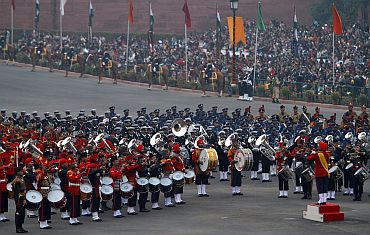
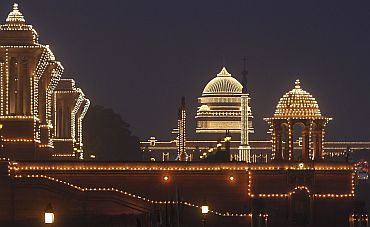
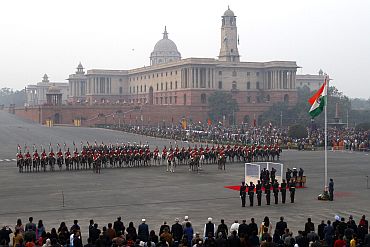
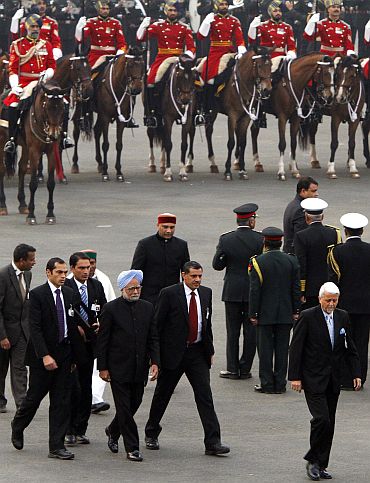
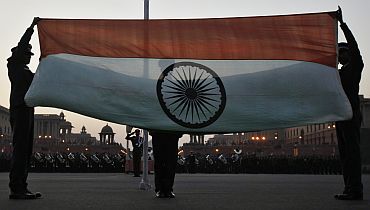
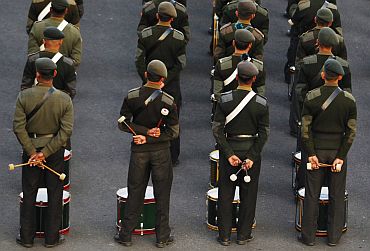

article